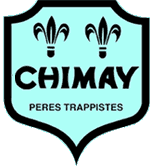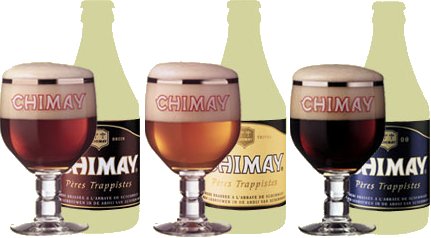 |

|
|

|
|
|
 |

home
about
features
A-Z
books

|

|

Protz:
features
reviews
tastings
|

| |
the beers of Chimay. Plus ca Change...
by Willard Clarke, 05/05
I sometimes feel that a song of yesteryear, You Always Hurt the One You Love, should be the anthem of beer lovers of the anorak persuasion. I have lost count of the number of times I have been told that a renowned beer has been ruined beyond redemption because the ingredients have changed or the company is motivated solely by the vulgar pursuit of the fast buck.
The charge has been levelled against the best-known of the Belgian monastic brewers, Chimay. The argument is that the monks have "dumbed down" their beers by
using such inferior ingredients as malt extract, wheat starch and hop extract in the brewery.
Some of the criticism, on websites in particular, is couched in a style of vulgar abuse that doesn't warrant attention. But a number of serious and well-disposed writers have also levelled the criticism that beer quality has declined. |
|

|
Tim Webb, in the latest edition of his CAMRA Good Beer Guide to Belgium and Holland, says the "recipe has been downgraded to exclude whole hops and replace them with hop extract only."
He goes on: "The brewery told CAMRA's newspaper What's Brewing in 2001 that there had been no recipe change since 1969. This is unlikely to be true as hop extract was not known to be used in commercial brewing in those days. Up to a third of the beers' grain base is wheat starch and candy sugar."
Tim's tasting notes describe the three beers, known as Red, White and Blue from the colour of their caps, as having "little body...a rather caustic bitterness...backtastes of damp cardboard...a pretentious pastiche of its old self".
I am fascinated by the Trappist tradition in Belgium where six breweries attached to monasteries produce bottle-fermented beers of the highest quality. I have seen them encircled by a growing number of commercial "abbey beers" produced by breweries that want to cash in on the Trappist heritage.
Far from giving in to commercial pressure, the monks have vigorously defended their tradition. In 1997, they set up the International Trappist Association to place a common seal, "Authentic Trappist Product", on their labels. When the Dutch La Trappe brewery was taken over by a large commercial company, Bavaria, it was expelled from the association and instructed to remove the word Trappist from its labels.
Is it possible that Chimay would help set up the association while it was reducing the quality and standing of its own beers?

|
|
Before my most recent visit, I had twice been to Chimay, known officially as the Abbaye Notre Dame de Scourmont in Hainaut province, close to the French border. On both occasions I met Father Thomas, the
monk in charge of brewing, an ebullient and engaging man who took me through a tasting of several vintages, accompanied by passionate views on cellaring, temperature, age in bottle, and venting the beers before
drinking. (left, Saint Benoit, who's rules are followed by Trappist monks). |
Father Thomas has since died, robbing me of the possibility of speaking to someone with long experience of the brewery and the ingredients used. On one visit, however, I also met a lay brewer, Paul Arnott, a graduate of Heriot-Watt brewing school in Edinburgh. He left Chimay some years ago but I was able to track him down at Unibroue, the highly-regarded producer of French and Belgian-style beers in Francophone Canada, where he is the master brewer.
Paul's thoughts are instructive. He says emphatically that the recipes for the beers have not changed since they were formulated after World War Two by head brewer Father Theodore. He worked with the legendary scientist Jan De Clerck from the brewing faculty at Leuven University. They formulated a yeast strain in 1948 that works at unusally high temperatures and which is responsible for the spicy, peppery character of the beers.
Paul added: "The recipes are always based on malt grain. A small amount of adjunct in the form of wheat starch is used. As far as hops are concerned, it was Father Theodore who introduced liquid CO2 extracts. The whole hops, which are macerated to make pellets, are extracted by liquid CO2, which extracts all the good stuff, leaving behind the hard resins and solid material. It's an entirely natural process which gives a high quality and especially stable product."
He commented that he had recently returned to Chimay and had "drunk copious amounts of Chimay Blanche and Bleue. I found the quality to be both exquisite and full-bodied."
On my most recent visit, I was struck as always by the serenity of the abbey, vibrant with bird song. It is a place of retreat, worship and study. It's essential to grasp this, for the
lay people running the brewery - whose income supports the work of the monks - have to respect the fact that this is a religious establishment where silence is essential.
The design of the brewery - a new one was installed in 1988 - has to cope with greatly increased volumes (120,000 hectolitres a year) as a result of international demand for the beers, but has to remain compact and quiet. This accounts for the fact that bottling, always a noisy business, has been moved off-site to a commercial company.
Where ingredients are concerned, quality control manager Dominque Denis and production manager Jean-Micael Degraux were emphatic that nothing had changed since the time of Father Theodore. They pointed out, with perhaps a hint of righteous anger, that the brewery introduced the listing of ingredients on labels in the late 1990s. There are no requirements under Belgian law to do this, but now the brewery finds itself under attack for its openness.
They denied they use wheat starch. They use wheat flour, between 10 and 15%, for head retention. This is a problem of translation, for the labels clearly state starch. Denis and Degraux say they would like to correct this but fear that if they change the labels they will be accused of further tinkering with the recipes.
They are bemused by critics who accuse them of using candy sugar. It was phased out 40 years ago. Pure dextrose is used in the brewhouse while liquid invert sugar is used for secondary fermentation in bottle. Sugar accounts for 5% of the fermentable materials.
As for malt extract, Dominque Denis picked up a large felt-tip pen and wrote in huge letters on a display board: "0.1%". He said the extract is added purely for colour adjustment as the main malts used, pale and caramalt, can vary slightly in colour. He said the brewery plans to buy caramalt to a better specification and will phase out malt extract.
I sat in on the daily tasting of beers.
We had samples of:
Red (7% ABV),
White (8% ABV) and Blue (9% ABV) that were two months old and were rich with
malt, spicy, peppery hops, and earthy, berry fruits. |
|

|
We were then presented with two bottles of Grande Reserve, a 75cl corked and cradled version of Blue from 1997, and from 1995. They were much darker than the young version, with a big aroma of sultanas and raisins, with dry fruit dominating the palate and finish.
Sample of Red and Blue that I have tasted in Britain recently have been less complex than I remember them. On my trip, Jean-Micael Degraux said: "The recipe hasn't changed, but yeast will adapt to its environment." The beers are now fermented in conicals rather than open squares. This will speed up fermentation, which lasts for between four to six days.
That, I believe, is the result of some change and slight diminution of complexity in the beers, not a sell-out by the monks to the forces of commercialism. I am well aware that this is unlikely to satisfy those who prefer the conspiracy theory of history.
|
|
home
about
features
A-Z
books
|

